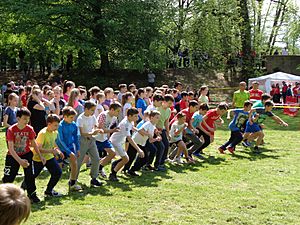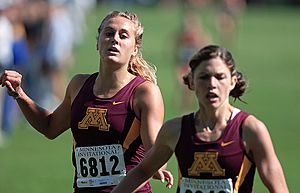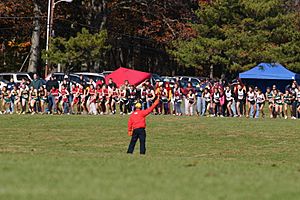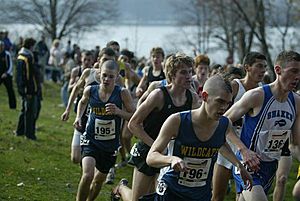Cross country running facts for kids

Runners competing in a cross country race in Minnesota
|
|
| Highest governing body | World Athletics |
|---|---|
| Presence | |
| Olympic | 1912–1924 |
| World Championships | 1973– |

Cross country running is an exciting sport where individuals and teams race outdoors. They run on natural ground like dirt paths or grassy fields. The race courses are usually between 4 and 12 kilometers (about 2.5 to 7.5 miles) long. They can go through forests, open fields, and might have hills or flat sections. Sometimes, there are small obstacles or gravel roads.
This sport is both for individuals and for teams. Runners are judged by their own finish times. Teams get points based on how well their runners do together. Boys and girls of all ages can compete. Cross country races usually happen in the fall and winter. This means runners might face rain, snow, or cold weather! It's a part of athletics, like a natural version of long-distance track and road races. The rules for cross country racing first came from Britain. The first national competition was in England in 1876. The first international race was in 1903. Today, the biggest competition for top runners is the World Athletics Cross Country Championships, which started in 1973.
Contents
Race Course
Designing a Course
Cross country courses are made for continuous running. They don't have big walls to climb or deep ditches to jump, like military obstacle courses. A good course is at least 5 meters (about 16 feet) wide. This allows runners to pass each other safely during the race.
Clear signs are very important to make sure runners don't get lost and spectators don't get in the way. These signs can be tape, chalk, paint, or cones. Some races use colored flags: red for a left turn, yellow for a right turn, and blue to go straight. Courses also usually have signs showing the distance, like at every kilometer or mile.
At the start, there should be a straight, flat section of about 400 to 1200 meters (about a quarter to three-quarters of a mile). This helps prevent too much crowding and bumping at the beginning of the race. After the finish line, there's often a special area called a "chute." This helps officials record where each runner finishes.
Race Distances
For big international races, the course is usually a loop between 1750 and 2000 meters (about 1 to 1.2 miles) long. Athletes run several loops to complete their race.
- Senior (older) men and women usually run 10 kilometers (about 6.2 miles).
- Junior (younger) men run 8 kilometers (about 5 miles).
- Junior women run 6 kilometers (about 3.7 miles).
In the United States:
- College men typically run 8 km (5 miles) or 10 km (6.2 miles).
- College women usually race 5 km (3.1 miles) or 6 km (3.7 miles).
- High school students often run 3 miles (4.8 km) or 5 km (3.1 miles).
Strategy
Cross country courses are all different. Some are muddy, some have lots of turns, and some have big hills. Because of this, there isn't one perfect way to run a race. Some runners and coaches think it's best to start fast to get ahead of the crowd. Others believe it's better to run at a steady speed to save energy.
Some teams like to run in a group to encourage each other. Other teams let each runner run their own race. It's also important to decide if you want to lead the race or stay behind and then speed up at the end. This often depends on how skilled and fit a runner is, and how long the race is. What you eat before the race and how you train are also very important for success!
Equipment
You don't need much special gear for cross country running. Most runners wear shorts and a lightweight top, often in their club or school colors. If it's very cold, they might wear long-sleeved shirts and tights to stay warm and still move easily.
The most common shoes are cross country spikes. These are light racing shoes with a rubber sole. They have five or more small metal spikes that screw into the front part of the sole. The length of the spikes depends on the course. For a muddy course, longer spikes (up to 25 mm or 1 inch) work best. For harder ground, shorter spikes (as short as 6 mm or 0.25 inches) are better. If a course has a lot of paved roads or hard dirt, runners might choose to wear racing flats. These are rubber-soled shoes without spikes.
History

The sport of cross country running began in the 1800s. It came from an old English game called "hare and hounds" or "the paper chase." In this game, one person (the "hare") would run ahead, leaving a trail of paper. Others (the "hounds") would chase them.
English schools started having cross country races in 1837. The first "open" national championship, where anyone could compete, was held on December 7, 1867, in London. This early race was about 3.5 miles long and went over very muddy and hilly land. It was meant to be like steeplechase training for the off-season. The course wasn't marked well, and many runners got lost. The race even started at 5 PM, so it was dark!
Olympic Games
Cross country running was part of the Olympic Games in 1912, 1920, and 1924. Sweden won gold in 1912. Finland, led by the famous runner Paavo Nurmi, won gold in 1920 and 1924.
The 1924 Olympic race in Paris was very tough because of extremely hot weather (over 40°C or 104°F). Many runners struggled to finish. Because of how difficult this race was, Olympic officials decided to remove cross country running from future Summer Games. Since 1928, cross country has only been a small part of the modern pentathlon event at the Olympics.
World Championships
Since 1973, the World Athletics Cross Country Championships have been held every year. In 1975, New Zealand (men) and the United States (women) won, which was the first time non-European countries won. In 1981, Ethiopia became the first African nation to win the men's race. Ten years later, Kenya became the first African nation to win the women's race.
Since 1981, either Ethiopia or Kenya has won almost every men's world title. Since 2001, they have won almost every women's title too. By 2010, Kenya had won 40 World Cross Country Championships, and Ethiopia had won 23.
Famous Athletes
- Kenenisa Bekele is considered one of the greatest male cross country runners ever. He won both the short and long World Cross Country titles five times in a row (2002–2006).
- Edward Cheserek is the only athlete to win three straight individual NCAA Division I championships (2013, 2014, and 2015).
Regional Organizations
Many countries have their own cross country events and organizations.
Australia
In Australia, cross country running is organized by athletics groups in each state. For runners over 30 (Masters category), it's handled by Australian Masters Athletics. The cross country season in Brisbane usually runs from March to September. There's often a race each week in a different park, hosted by local clubs.
Canada
Cross country running is very popular in Canada. In middle school, races are divided by grade and gender. In high school, these races help find talented runners who might go on to compete at university or national levels. University-level races are managed by Canadian Interuniversity Sport.
India
The Athletics Federation of India holds a National Championship every year. Nagaland hosted the 56th National Cross Country Championship. There's also an extreme cross country race called the Himalayan Adventure Challange held on mountain slopes.
United Kingdom
Many primary (elementary) schools in the UK, especially juniors, take part in cross country events. Some areas have done this since the late 1960s. For example, schools near Ouston, County Durham compete as part of a local cross country association.
United States

USA Track & Field (USATF) hosts four national cross country championships each year. The USA Cross Country Championships, which started in 1890, include six different races for various age groups and distances. These championships also help choose the US team for the World Cross Country Championships. Other national events include the USATF Masters 5 km Cross Country Championships, the USATF National Club Cross Country Championships (for top clubs), and the USATF National Junior Olympic Cross Country Championships (for younger runners).
Most American universities and colleges have men's and women's cross country teams. Over 900 men's teams and 1000 women's teams compete in the National Collegiate Athletic Association (NCAA). Men usually race 10 km or 8 km, and women usually race 6 km or 5 km.
Every state offers cross country as a high school sport. More than 440,000 high school students compete each year, making it one of the most popular sports for both boys and girls. High school races are typically 3 miles or 5 km long.
Mt. San Antonio College (Mt. SAC) in Walnut, California, hosts the biggest cross country event in the United States. Over 22,000 runners from colleges, high schools, and elementary schools compete there. This meet started in 1948 and is still going strong today.
Notable Races
- World Athletics Cross Country Championships: This is a big international race where athletes from different countries compete. It's held every two years and is known as a very challenging event.
- NCAA Division I Cross Country Championships: These races are held every fall for college men and women by the NCAA. Runners represent their schools and can qualify as a team or as individuals.
- USATF National Club Cross Country Championships: This is an annual competition hosted by USA Track and Field. It features different races for masters (older) runners and open (elite) runners. The open races help select athletes for the World Cross Country Championships.
- Great Edinburgh International Cross Country: This competition used to be held every year in Edinburgh, Scotland. It had races for junior men and women, and senior men and women. It attracted top runners but has not been held since 2019.
Notable Courses
- Franklin Park in Boston, Massachusetts, is a very famous cross country course. It hosted the World Cross Country Championships in 1992. It's used for high school, college, and professional races.
- Van Cortlandt Park in the Bronx, New York, is called "the most storied cross country course in the United States." It has hosted NCAA and world championships and is used by many top runners for training.
- Lavern Gibson in Terre Haute, Indiana, is known as "Cross Country Town USA." It's the home course for Indiana State University and has hosted the NCAA Division I Cross Country championships many times. This course was specially designed just for cross country races.
- Thomas Zimmer Championship Course is at the University of Wisconsin. It opened in 2009 and hosted the 2018 NCAA Cross Country Championship. It also hosts a large college competition called the Nuttycomb Wisconsin Invitational.
See also
 In Spanish: Campo a través para niños
In Spanish: Campo a través para niños



